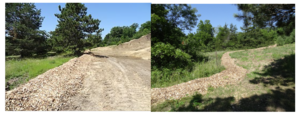
Difference between revisions of "Construction stormwater best management practice – buffer zones"
(Created page with "===Buffer zones=== An undisturbed buffer zone of not less than 100 linear feet from a special water is required in the construction stormwater general permit. Special waters...") |
|||
| Line 6: | Line 6: | ||
Riparian buffers are vegetated zones adjacent to streams and wetlands that represent a best management practice (BMP) for controlling many pollutants found in typical stormwater runoff. Many studies have shown that by maintaining a buffer around surface waters pollutant impacts from sediment, phosphorus, nitrogen and thermal impacts can be greatly reduced. In addition to the benefits of buffers as a long term stormwater BMP, maintaining a buffer during construction reduces the risk of a sediment discharge when it rains. | Riparian buffers are vegetated zones adjacent to streams and wetlands that represent a best management practice (BMP) for controlling many pollutants found in typical stormwater runoff. Many studies have shown that by maintaining a buffer around surface waters pollutant impacts from sediment, phosphorus, nitrogen and thermal impacts can be greatly reduced. In addition to the benefits of buffers as a long term stormwater BMP, maintaining a buffer during construction reduces the risk of a sediment discharge when it rains. | ||
| + | |||
| + | [[File:Riparian buffers.PNG|right|thumb|300 px|alt=This photo shows Riparian buffers|<font size=3>Riparian buffers</font size>]] | ||
Revision as of 17:55, 1 March 2016
Buffer zones
An undisturbed buffer zone of not less than 100 linear feet from a special water is required in the construction stormwater general permit. Special waters are defined in Appendix A of the permit. Determining if your site is near special water can be quickly determined using the online mapping tool. Examples include the Mississippi River, Lake Superior, scenic or recreational river segments, wilderness areas, trout streams, and calcareous fens.
Riparian buffers
Riparian buffers are vegetated zones adjacent to streams and wetlands that represent a best management practice (BMP) for controlling many pollutants found in typical stormwater runoff. Many studies have shown that by maintaining a buffer around surface waters pollutant impacts from sediment, phosphorus, nitrogen and thermal impacts can be greatly reduced. In addition to the benefits of buffers as a long term stormwater BMP, maintaining a buffer during construction reduces the risk of a sediment discharge when it rains.
